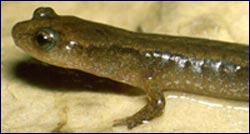Habitat microstructure drives salamander metamorphosis

Oklahoman salamander
Whether salamanders transform into their terrestrial, adult form or retain their aquatic, juvenile form depends on the nature of the streambed where they develop. A study published today in the open access journal BMC Biology reveals that the Oklahoma salamander Eurycea tynerensis metamorphoses into a more terrestrial adult form in streambeds composed of fine, tightly packed gravel but retains its juvenile, or paedomorphic, form in streambeds made of large, loosely packed particles. This study highlights how a simple difference in habitat microstructure can have a major influence on patterns of development, morphology and evolution.
Ronald Bonett and Paul Chippindale from the University of Texas at Arlington, Texas, USA, analysed the type, size and degree of sorting of streambed sediments for 22 populations, 11 paedomorphic and 11 metamorphic, of the plethodontid salamander E. tynerensis living on the Ozark Plateau in south-central North America.
Bonett and Chippindale’s results show that paedomorphic salamanders prevailed in streambeds made of large well-sorted gravel, whereas metamorphic salamanders were found where streambeds consisted of small, unsorted sediments. The authors found a strong negative correlation between small streambed sediments and paedomorphosis.
Bonett and Chippindale explain that large gravel creates porous streambeds with large spaces between particles, where aquatic paedomorphic salamanders can access sub-surface water during dry months. However, if these spaces are filled in by small particles, metamorphosis is the only way they can survive when surface streams dry-up.
Media Contact
More Information:
http://www.biomedcentral.comAll latest news from the category: Life Sciences and Chemistry
Articles and reports from the Life Sciences and chemistry area deal with applied and basic research into modern biology, chemistry and human medicine.
Valuable information can be found on a range of life sciences fields including bacteriology, biochemistry, bionics, bioinformatics, biophysics, biotechnology, genetics, geobotany, human biology, marine biology, microbiology, molecular biology, cellular biology, zoology, bioinorganic chemistry, microchemistry and environmental chemistry.
Newest articles

Microscopic basis of a new form of quantum magnetism
Not all magnets are the same. When we think of magnetism, we often think of magnets that stick to a refrigerator’s door. For these types of magnets, the electronic interactions…

An epigenome editing toolkit to dissect the mechanisms of gene regulation
A study from the Hackett group at EMBL Rome led to the development of a powerful epigenetic editing technology, which unlocks the ability to precisely program chromatin modifications. Understanding how…

NASA selects UF mission to better track the Earth’s water and ice
NASA has selected a team of University of Florida aerospace engineers to pursue a groundbreaking $12 million mission aimed at improving the way we track changes in Earth’s structures, such…





















